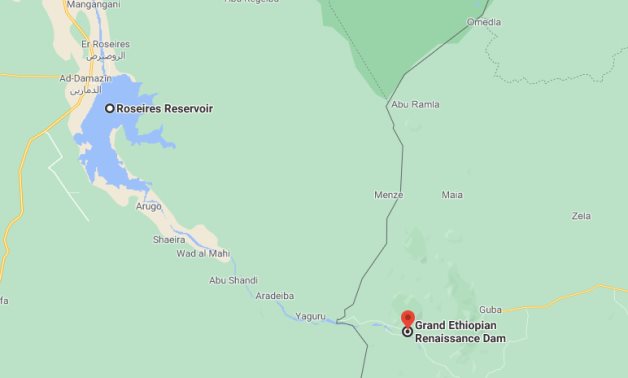
A map shows the locations of Roseires reservoir in Sudan and Grand Ethiopian Renaissance Dam- A screenshot of Google Maps
CAIRO – 27 February 2021: Failure of reaching a binding agreement on filling and operating the controversial Grand Ethiopian Renaissance Dam (GERD) and the refusal of providing data from the Ethiopian side will significantly negatively affect the operation of the Sudanese Roseires reservoir, said Manager of Roseires reservoir Hamed Mohamed Ali on Saturday.
In remarks to the Sudanese News Agency (SUNA), Ali said that the Sudanese Roseires dam will depend on the quantities of the river coming from the Renaissance Dam, and thus the absence of a binding and satisfactory agreement for all parties will constitute a great danger.
Sudan’s Roseires dam, which is located near the Sudanese border with Ethiopia, has productive and economic importance in irrigating agricultural projects along the Blue Nile and the Nile, and producing electricity, he added.
In a meeting with a delegation from DR Congo on Friday, Sudanese Prime Minister Abdalla Hamdok has warned against the unilateral filling of the Ethiopian massive dam before an agreement can be reached between the concerned countries.
Hamdok said that such act would harm dams and properties of the people living along the Nile River banks.
This comes while Ethiopia has frequently affirmed it would implement the second filling of the Grand Ethiopian Renaissance Dam next July under any circumstances.
Egyptian Minister of Water Resources and Irrigation Mohamed Abdel-Atti said that Sudan worried because of what happened last year when Ethiopia began filling the dam reservoir without notifying Sudan, adding that Sudan was negatively affected.
In mid-July 2020, Ethiopian authorities unilaterally carried out the first phase of the filling process with 4.9 billion cubic meters; and it is expected that the second phase of the filling would reach 13 billion cubic meters in July.
The dispute among Egypt, Sudan, and Ethiopia dates back to May 2011 when Ethiopia started building the dam; Egypt voiced concern over its water share [55.5 billion cubic meters].
As Democratic Congo is chairing the AU for the year 2021, it is attempting to revive stalling negotiations between Egypt, Sudan, and Ethiopia.
In 2015, the three countries signed the Declaration of Principles, per which the downstream countries should not be negatively affected by the construction of the dam.
In October 2019, Egypt blamed Addis Ababa for hindering a final agreement concerning a technical problem, calling for activating Article No. 10 of the Declaration of Principles, which stipulates that if the three countries could not find a solution to these disputes, they have to ask for mediation.
Washington had brokered tripartite negotiations among the three countries, in the presence of the President of the World Bank (WB) starting from November 6, 2019 until February 27 and 28, 2020.
During these rounds of talks, tangible outcomes were agreed on among the three parties concerning the rules and mechanism of operating the dam and the filling process of the reservoir during drought and prolonged drought; however, an agreement was not sealed.
Constructions in the Grand Renaissance Dam started on April 2, 2011 at a cost of $4.8 billion. The dam is located on the Blue Nile with a capacity of 74 billion cubic meters, and is expected to generate up to 6,000 megawatts of power.

Comments
Leave a Comment